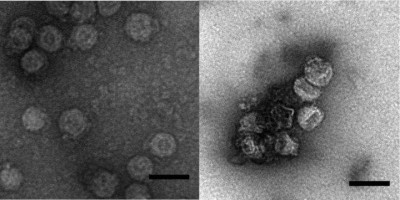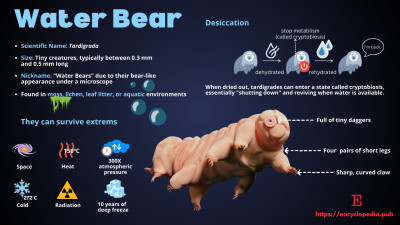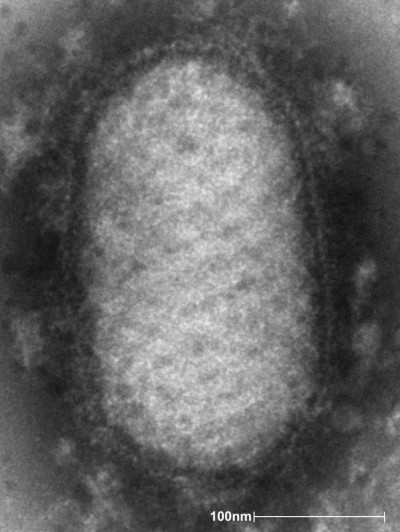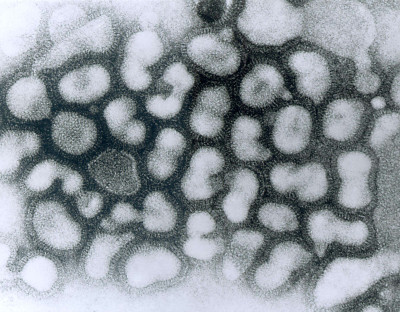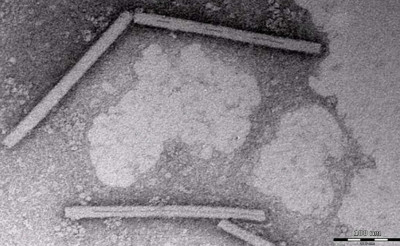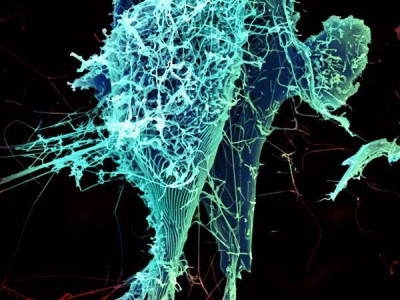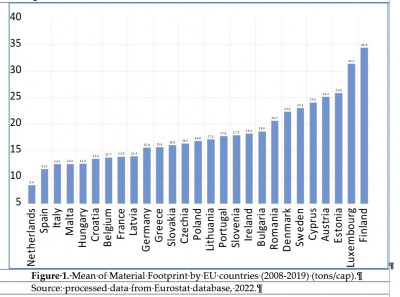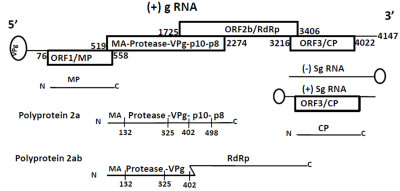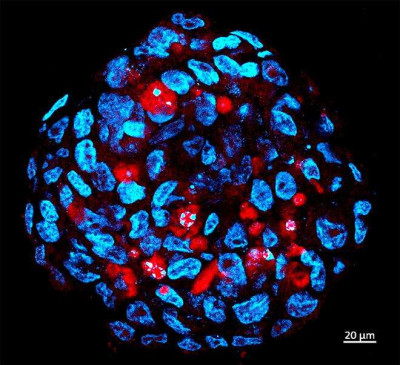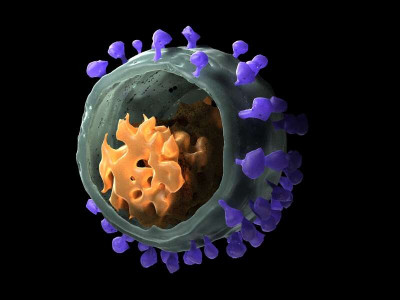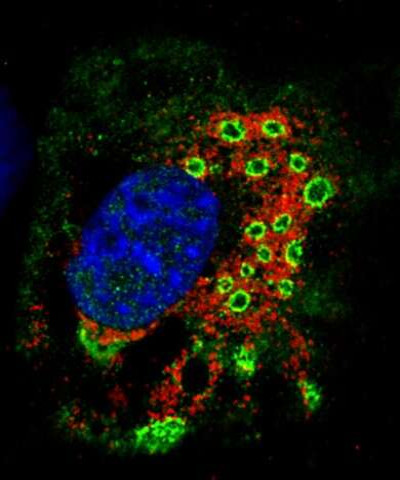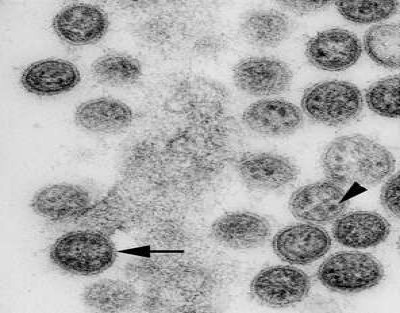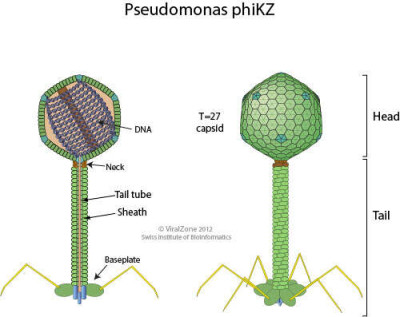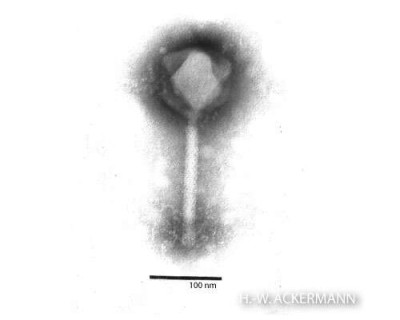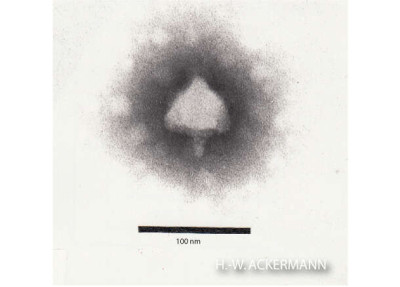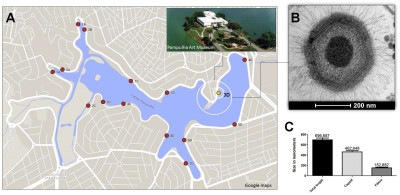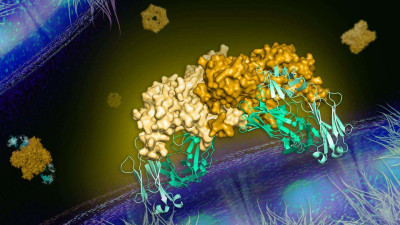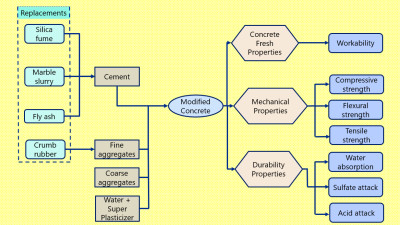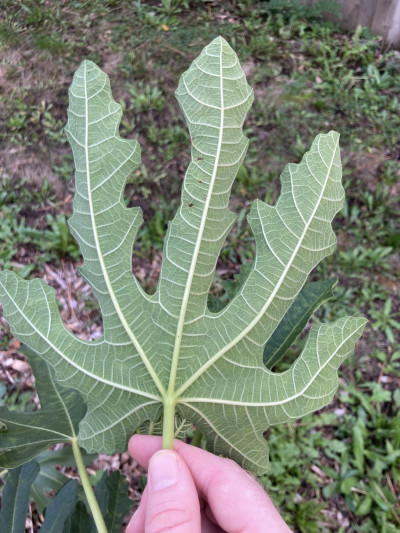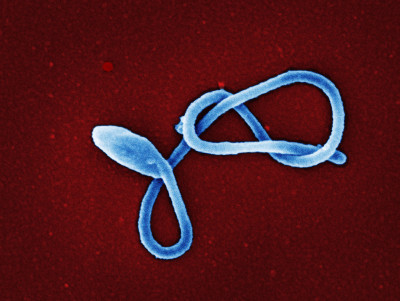Virions of Pseudomonas virus phi6. Left: normal. Right: coagulated. Scale bar, 100 nm.
Wikimedia Commons, EurekAlert!
18 Apr 2024
Water bears, or tardigrades, are microscopic creatures known for their incredible survival skills. Despite their tiny size, they can endure extreme environments, from the vacuum of space to intense radiation, heat, and cold. Discover how these resilient organisms thrive in conditions that would be lethal to most other forms of life, and learn why they’re often called “the toughest creatures on Earth.” Explore their unique survival mechanisms in our infographic!
Encyclopedia Editorial Office
13 Nov 2024
This negative-stained transmission electron micrograph (TEM) image depicted the ultrastructural details of an Orf virus, a member of the genus Parapoxvirus. Note the spiral arrangement of the external tubular ridges on the ovoid-shaped virus particle, or virion.
Public Health Image Library
16 Jan 2024
From 1981, this transmission electron microscopic (TEM) image depicts numbers of Influenza A virions, while in their late passage growth phase.
Public Health Image Library (PHIL)
24 Jan 2024
Electron microscopy of Pepper mild mottle virus (PMMoV)-RNA positive samples. The samples analyzed by electron microscopy were from Tabasco sauce. [1]
Wikimedia Commons, Philippe Colson, Hervé Richet, Christelle Desnues, Fanny Balique, Valérie Moal, Jean-Jacques Grob, Philippe Berbis, Hervé Lecoq, Jean-Robert Harlé, Yvon Berland, and Didier Raoult
25 Jan 2024
After multiplying inside a host cell, the string-like Ebola virus is emerging to infect more cells. Ebola is a rare, often fatal disease that occurs primarily in tropical regions of sub-Saharan Africa.
Wikimedia Commons, Heinz Feldmann, Peter Jahrling, Elizabeth Fischer and Anita Mora, National Institute of Allergy and Infectious Diseases/ NIH Image Gallery
29 Jan 2024
Material Footprint measures the global demand for material extracted (biomass, metal ores, non-metallic minerals and fossil energy materials/carriers) to satisfy investment by households, governments and businesses in the EU. Raw material consumption is a measure of material footprints, being calculated as raw material input minus exports (calculated at the aggregate product level, by material). The indicator gives an understanding of the quantity and type of materials needed to meet the request for products in each economy. It is measured in Tones per capita and covers the period 2008-2019 (Figure 1). Figure 1 shows that EU member states could be clustered in several groups, depending on the value recorded in the period 2008-2019 (average values). The highest value is found in Finland (34.4 t/cap) and Luxemburg (31.5 t/cap). The second group includes countries which have recorded high values for Material Footprint, between 20 and 26 t/cap. (Romania, Denmark, Sweden, Cyprus, Austria, and Estonia). The third group includes 10 countries that recorded values between 15 t/cap. and 18.6 t/cap. It is important to notice that Germany, the biggest EU country, has a value situated at the bottom of the third group (15.6 t/cap). The fourth group is composed of eight countries with a Material Footprint indicator in the range of 11.5-14 t/cap. In this group are included some of the biggest economies of the EU (France, Italy, Spain). The lowest value of the indicator (8.4 t/cap) is documented in the Netherlands. At the aggregate level of the EU, the MF recorded a slow descending evolution: from 17,86 t/capita in 2008 to 14,57 t/capita in 2019. That means a reduction of 3,28 t/capita (18,37%) in 11 years.
29 Jan 2024
Genome organization: sesbania mosaic virus (SeMV) is a single stranded RNA virus with genome size of 4147 nt. The 5′ end of the genome is covalently linked to VPg and the 3′ end lacks polyA tail. ORF 1 encodes movement protein and ORF 3 encodes the coat protein which is expressed through a subgenomic RNA (sgRNA). The ORF 2 codes for two polyproteins 2a and 2ab. The numbers indicate the position of start and stop codons in each of the ORFs. The polyprotein 2a contains N-terminal membrane anchor (MA)-protease-VPg-p10-p8 domains. The polyprotein 2ab contains N-terminal membrane anchor (MA)-protease-VPg-RdRp. The RdRp is expressed through a −1 ribosomal frame shifting mechanism. The numbers in the polyproteins 2a and 2ab indicate the cleavage site positions [1].
Wikimedia Commons, Kunduri Govind, Kristiina Mäkinen, Handanahal S. Savithri
02 Feb 2024
Tumor sphere comprised of human medulloblastoma stemcells infected by Zika (red). [1]
HUG-CELL, Wikimedia Commons
07 Feb 2024
Rendering of 3D structure of a single simian immunodeficiency virus obtained using cryo-electron tomography.
National Cancer Institute (NCI), National Institutes of Health (NIH), Wikimedia Commons
08 Feb 2024
Rotavirus-infected cell revealing numerous viral factories in the cytoplasm.
NIAID, Wikimedia Commons
08 Feb 2024
Transmission electron micrograph of an ultrathin section of Vero cells infected with Cygnet River virus (CyRV) from a Muscovy duck, Australia. Arrow, virus budding from the plasma membrane; arrowhead, sand-like structures. [1]
Allan Kessell, Alex Hyatt, Debra Lehmann, et. al, Wikimedia Commons
23 Feb 2024
Schematic drawing of a Pseudomonas virus phiKZ virion (cross section and side view).
ViralZone, SIB Swiss Institute of Bioinformatics, Wikimedia Commons
01 Mar 2024
Electron micrograph of a virus particle of the species Pseudomonas virus phiKZ.
ViralZone, SIB Swiss Institute of Bioinformatics, Wikimedia Commons
01 Mar 2024
EM image of a virion of the genus Teseptimavirus (aka T7likevirus).
ViralZone, SIB Swiss Institute of Bioinformatics, Wikimedia Commons
01 Mar 2024
(A) Shows a map of the Pampulha Lagoon, from where the samples were collected. Red dots: collection points; yellow dot: NYMV isolation site. (B) Shows an image of a NYMV particle, observed in electron microscopy. (C) Shows the size, in nanometers, of different components of the NYMV particle: only the fibers, only the capsid and the particle as a whole. [1]
Wikimedia Commons, Boratto PVM, Arantes TS, Silva LCF, Assis FL, Kroon EG, La Scola B and Abrahão JS
08 Mar 2024
A 2B7 antibody, in green, neutralizing the NS1 protein of the dengue virus.
Wikimedia Commons, Rajani Arora
11 Mar 2024
This flowchart presents a comprehensive overview of the various modifications applied to concrete mixtures to enhance its properties and performance. The left section outlines potential replacement materials for traditional concrete components, including silica fume, marble slurry, fly ash, and crumb rubber. These materials can be used to replace portions of the cement or aggregates, thereby altering the concrete's composition for specific applications or sustainability goals.
Central to the diagram is "Modified Concrete," which signifies the resultant material after incorporating the replacements. This modified concrete is then analyzed based on two primary characteristics: Fresh Properties and Mechanical and Durability Properties.
The "Concrete Fresh Properties" focuses on the workability of the concrete mix, an important factor during the mixing and pouring phases. Meanwhile, "Mechanical Properties" explores the concrete's strength parameters, including compressive, flexural, and tensile strengths. These are critical for determining the load-bearing capacity and structural integrity of the concrete.
Lastly, "Durability Properties" assesses the concrete's long-term performance against environmental factors such as water absorption, sulfate attack, and acid attack. These factors contribute to the longevity and maintenance requirements of concrete structures.
Overall, this diagram serves as a useful guide for engineers and material scientists looking to tailor concrete properties for specific construction requirements and sustainability considerations.
07 Apr 2024
The primary host of Fig mosaic emaravirus is the fig tree (Ficus carica), a deciduous tree known for its delicious and nutritious fruit. Fig trees are cultivated worldwide for their edible fruit and ornamental value. Infected fig trees typically display symptoms of mosaic patterns on leaves, which appear as irregular patterns of light and dark green patches. These mosaic patterns can vary in severity, and in some cases, infected leaves may also show puckering or distortion.
iNaturalist
11 May 2024
Colorized scanning electron micrograph of a single filamentous Ebola virus particle (colorized blue). Image captured and color-enhanced at the NIAID Integrated Research Facility in Ft. Detrick, Maryland.
NIAID, Wikimedia Commons
24 Jan 2024
 Encyclopedia
Encyclopedia
